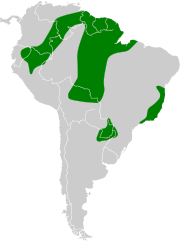Hylocharis
| Hylocharis | |
|---|---|

| |
| Gilded sapphire (Hylocharis chrysura) photographed in São Paulo, Brazil. | |
| Scientific classification | |
| Domain: | Eukaryota |
| Kingdom: | Animalia |
| Phylum: | Chordata |
| Class: | Aves |
| Clade: | Strisores |
| Order: | Apodiformes |
| Family: | Trochilidae |
| Tribe: | Trochilini |
| Genus: | Hylocharis Boie, F, 1831 |
| Type species | |
| Trochilus sapphirinus (rufous-throated sapphire) Gmelin, JF, 1788
| |
| Species | |
|
2, see text | |
Hylocharis is a genus of hummingbirds, in the family Trochilidae. It contains two species that are both found in South America.
Taxonomy[edit]
The genus Hylocharis was introduced in 1831 by the German naturalist Friedrich Boie.[1] The type species was designated by the English zoologist George Robert Gray in 1840 as the rufous-throated sapphire.[2][3] The genus name combines the Ancient Greek hulē meaning "woodland" or "forest" with kharis meaning "beauty".[4]
This genus formerly included additional species. A molecular phylogenetic study published in 2014 found that the genus Hylocharis was polyphyletic.[5] In the revised classification to create monophyletic genera, species were moved to Chrysuronia and Chlorestes.[6][7]
The genus now contains the following two species:[6]
| Common name | Scientific name and subspecies | Range | Size and ecology | IUCN status and estimated population |
|---|---|---|---|---|
| Rufous-throated sapphire | Hylocharis sapphirina (Gmelin, JF, 1788) |
Bolivia, Brazil, Colombia, Ecuador, the Guianas, Peru, Venezuela and possibly Argentina and Paraguay
|
Size: Habitat: Diet: |
LC
|
| Gilded sapphire | Hylocharis chrysura (Shaw, 1812) |
Argentina, Bolivia, Brazil, Paraguay, and Uruguay.
|
Size: Habitat: Diet: |
LC
|
References[edit]
- ^ Boie, Friedrich (1831). "Bemerkungen über Species und einige ornithologische Familien und Sippen". Isis von Oken (in German). Cols 538–548 [546].
- ^ Gray, George Robert (1840). A List of the Genera of Birds : with an Indication of the Typical Species of Each Genus. London: R. and J.E. Taylor. p. 14.
- ^ Peters, James Lee, ed. (1945). Check-List of Birds of the World. Vol. 5. Cambridge, Massachusetts: Harvard University Press. p. 52.
- ^ Jobling, James A. (2010). The Helm Dictionary of Scientific Bird Names. London: Christopher Helm. p. 197. ISBN 978-1-4081-2501-4.
- ^ McGuire, J.; Witt, C.; Remsen, J.V.; Corl, A.; Rabosky, D.; Altshuler, D.; Dudley, R. (2014). "Molecular phylogenetics and the diversification of hummingbirds". Current Biology. 24 (8): 910–916. doi:10.1016/j.cub.2014.03.016.
- ^ a b Gill, Frank; Donsker, David; Rasmussen, Pamela, eds. (January 2022). "Hummingbirds". IOC World Bird List Version 12.1. International Ornithologists' Union. Retrieved 2 August 2022.
- ^ Stiles, F.G.; Remsen, J.V. Jr.; Mcguire, J.A. (2017). "The generic classification of the Trochilini (Aves: Trochilidae): reconciling taxonomy with phylogeny". Zootaxa. 4353 (3): 401–424. doi:10.11646/zootaxa.4353.3.


